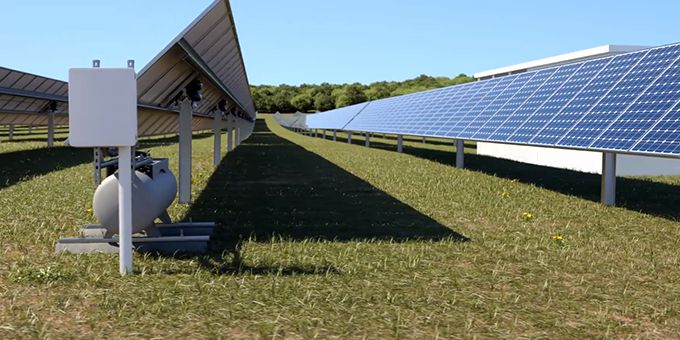The system has reservoir tanks that accumulate and store air to maintain a steady supply of regulated pressure. These tanks provide more than enough air to move the trackers to a stow position in the event of a power outage. Solar projects with trackers powered by electricity sometimes need batteries or backup generators to stow the equipment so it doesn’t obstruct maintenance personnel or increase risk of damage from wind or snow. With pneumatic power, no batteries are required. With the Sunfolding T29, tracker rows can also be moved to stow manually or automatically based on weather station outputs.
What happens if the system experiences air loss?
The Sunfolding T29 is designed for resiliency. Air pressure in the storage tank is regulated at 80-90 pounds per square inch (psi), comparable to the pressure in a bike tire. In the tubing that distributes air to the actuators, pressure is regulated at 30 psi. The Sunfolding T29 also has safeguards that allow for continued operation in the event that any part of the system has a drop in air pressure or loss of air.
At the distribution level, the control system has a valve manifold that regulates the air flow through tube harnesses into multiple actuators along the row. The tubing and connectors are durable and resilient to puncture. Both are used in the automotive industry. They are designed for far more adverse operating conditions than a solar project site.
Once air reaches the actuator, it enters through a pneumatic orifice that limits air flow. If one actuator sees a drop in pressure, because of a puncture or any reason, the orifice will control air loss and keep actuators working. In this way, any one compromised actuator has minimal effect on overall system downtime. The SAS and the tracker rows can continue to optimize energy output throughout the day.
What happens if moisture gets into the system?
As a ubiquitous resource, air is an excellent source of power. But it needs to be conditioned for use in a pneumatic system. Sunfolding’s Supply Air System (SAS) provides clean, dry air to the Tracker Controllers in the array. Ambient air is drawn in through filters in the enclosure doors and into the intake of the oil-free compressor. Compressed air is routed through a fan-powered aftercooler, coalescing filters, and a dryer to remove moisture from the supply air. The filters and tank are drained via timers or auto-drain float valves.
Do animals try to eat the hoses or nest in the actuators?
Pneumatic hoses and tubing are no more attractive to wildlife than electrical cables. But irregardless of the power source, some steps to deter animals work for large-scale solar.
For one thing, O&M best practices in recent years have begun to embrace the idea of encouraging natural predation. Instead of fencing that keeps out small animals like foxes and raccoons, projects are using barriers that ward off large animals like deer—and people—while allowing smaller mammals through. Once inside, they can help keep the population of nesters and nibblers in check.
Another strategy worth considering is to supplement wildlife habitat with perches and nesting boxes and piles of downed wood to give animals alternative places to make their home.
One advantage of pneumatic systems is that they use no electrical junction boxes or combiner boxes. Numerous enclosures around a large-scale project site increase the need for maintenance activities and, as a result, the cost. Solar projects and wildlife are both better off with fewer enclosures to inspect and remove animals from.
 5 Questions Developers Ask About Pneumatics
5 Questions Developers Ask About Pneumatics
